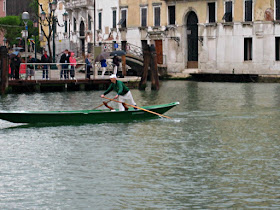 |
| The Return of the Bucentaur to the Molo on Ascension Day, 1730 by Canaletto |
(Venice, Italy) In one of the world's longest marriages, today Venice once again tossed her ring into the Sea, cementing a relationship that has endured for more than a thousand years. Oh, sure, there have been some quarrels, as in any intimate relationship, but Venice and the Sea have managed to endure century after century. Despite a few storms, floods and other shows of temper, Venice and the Sea always work out their differences and arrive at a state of
equilibrio. It is a beautiful day here in La Serenissima, full of sunshine and good feelings -- perfect weather for a wedding.
Last year the Festa della Sensa fell on the same day as the America's Cup, and I would like to take a moment to remember the Olympic gold medalist, Oliver Simpson, who died at the age of 36 on Thursday, May 9, 2013 after being trapped under the Artemis Racing catamaran when it capsized in San Francisco Bay during a routine training exercise for this year's America's Cup.
May he rest in peace. Last year I wrote a detailed post about the holiday:
Here is a long excerpt:
 |
| Festa della Sensa | |
|
|
|
|
The Ancient and the Contemporary, the Sacred and the
Profane merge once again in Venice. Today is Ascension Day, the day that
celebrates the bodily ascension of Jesus Christ into heaven. In Venice,
it is known as the Festa della Sensa; "sensa" is the word "ascension"
in the Venetian language. Whenever Venetians get their hands on a
special day, they like to pack as much power into that day as possible.
So, in the morning there is the traditional Festa della Sensa
celebration, and in the afternoon -- the America's Cup!
Festa della Sensa -- even without the America's Cup in town --
traditionally commemorates two different, important events in Venetian
history. The first took place on May 9, 1000 when Doge Pietro Orseolo II
rescued the Dalmatians from the Slavs.
The second event took place in 1177. Back in those days, the players involved were:
1. The Holy Roman Empire with the German Frederick I Barbarossa (aka Red Beard aka Kaiser Rotbart) as the Emperor.
a) Anti-pope Callixtus III, backed by Red Beard
2. The Republic of Venice, with Sebastiano Ziani as the Doge.
3. Pope Alexander III, backed by the Lombard League
 |
| Federico Zuccaro - Barbarossa Pays Homage to Alexander III |
|
Frederick I Barbarossa (Red Beard) was the German Holy Roman Emperor,
and he had his own anti-pope, Callixtus III. Red Beard was going around
conquering everybody, as emperors have a tendency to do. He was
particularly eager to conquer Italy, and was not fond of Pope Alexander
III, who had excommunicated him for his bad behavior. The only force
with any hope to stop Red Beard was the Lombard League, which was backed
by Pope Alexander III. The Battle of Legnano was fought and the Lombard
League won.
Just WHO was God's vicar on Earth? The Pope or the Emperor? That was the
question. It is not easy to get an Emperor and a Pope together in the
same town, but Venice managed to do just that. Pope Alexander III came
to Venice. Red Beard got as far as Chioggia, but was not allowed to land in Venice herself "until
he had set aside his leonine ferocity and put on the gentleness of the
lamb." Barbarossa became lamb-like, and was allowed into Piazza San
Marco, where he found Pope Alexander III surrounded by the Doge, the Patriarch, a host of cardinals and other luminaries. The
Emperor prostrated himself in front of the Pope, and received the kiss of
peace.
So, the Treaty, or Peace, of Venice in 1177 is also celebrated during the Festa della Sensa. From Old & Sold:
The astute Venetians extorted valuable
privileges both from the Pope and from the Emperor Frederick Barbarossa
as their reward for the part which they had played in the historic
reconciliation.
During his stay in Venice Alexander III was present at the famous
ceremony which was later known as the wedding of the Adriatic, a rite
which had been inaugurated by the great Doge Pietro Orseolo II, the
conqueror of Dalmatia. As a token of Papal approval of the ceremony the
Pope handed the Doge Sebastiano Ziani a consecrated ring with the words:
"Receive this as a pledge of the sovereignty which you and your
successors shall have in perpetuity over the sea."
For over 600 years this magnificent ceremony was enacted annually.
The Doge, surrounded by the Patriarch of Venice, the great officers of
State, and the foreign ambassadors, embarked on the large gilded barge,
the Bucintoro, and sailed through the Porto di Lido to the open
Adriatic. Here the Patriarch blessed the ring and gave it to the Doge,
who threw it into the sea, pronouncing the time-honoured formula: "Sea,
we wed thee in token of our true and perpetual dominion over thee." The
ceremony only came to an end with the extinction of the Republic in
1797.
 |
| Festa della Sensa by Canaletto |
Venice began celebrating Festa della Sensa again in 1965. The tradition
continues to this very day when Venice marries her husband, the sea,
except these days it is the mayor who throws a symbolic "ring" into the
sea in the waters off Lido. Then there are traditional regattas, a high
mass at the Church of San Nicolò, and a market on the grounds outside
the church.
Click HERE to continue reading.
Ciao from Venezia,
Cat
Venetian Cat - The Venice Blog













